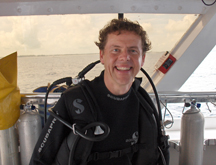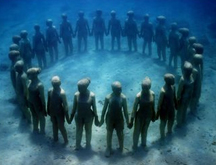


Top 10 Dive Destinations
Chris’ personal picks from places in the world that he has visited.
It was on a small, expedition-style cruise along the Great Barrier Reef that I first made my discovery: that as much as there is a wondrous world to explore on land, there are even more fabulous worlds to discover beneath the waves. I have been on dives of discovery ever since; these are my top personal picks of dive destinations around the world.
Roatan: This has long been a favourite destination for divers in the Caribbean, but it is becoming a more mainstream destination as direct flights from Canada and the US are now available. Politically a part of Honduras, in reality it is worlds apart and enjoys a privileged position on the second largest barrier reef in the world. It has everything needed for a spectacular diving vacation: shallow water snorkeling opportunities, wall and wreck diving, scuba lessons and certification in a number of diving resorts at very competitive prices.
Aruba/Bonaire:
These two sister islands of the Netherlands Antilles are located just off the coast of Venezuela and each has a strong attraction for divers based on the warm waters which average 27C and the great visibility of 20 to 30 metres which is the result of low run-off from these sunny isles. Bonaire has perhaps the best coral reef dive sites whilst Aruba has the most spectacular wreck sites – some just a few feet below the surface and accessible to snorkelers too.
Red Sea: The contrast of such extreme terrestrial desolation with such rich and diverse marine habitats is nowhere greater than here. Eilat in southern Israel is on the Gulf of Aqaba, a northern extension of the Red Sea and boasts more than 1,000 species of fish, 200 species of coral and another 1,000 species of invertebrates. Its underwater richness is so enveloping that when one surfaces amidst the drab desert scenery of the coast, it’s like slipping from a world of colour to one of black and white.
Cayman Islands: All three Cayman Islands are actually submerged Caribbean mountains tops so there are incredible walls all around the islands, some plummeting 6,000 meters to the abyssal depths. I had a wonderful shore dive off Turtle Reef with Sun Divers and saw not only turtle, but also grouper, barracuda, parrot fish, blue vase sponge and a veritable underwater jungle of corals and sponges. At 40 feet down, the coral wall was still bright and colourful in the brilliantly clear water.
Seychelles: This is a remote nation of 115 granite and coral islands extending from between 4 and 10 degrees south of the equator and lying between 480km and 1,600km from the east coast of Africa in the western Indian Ocean. I have visited but four of the islands but all have a variety of underwater opportunities second to none. My favourite spots are the impressive granite reef locations where the sculptured rocks are covered with soft corals and sponges, and fish life is prolific, due to the archipelago's isolation and sensible conservation rules.
Grenada: With the professional guidance of Grenada Dive, I got to explore one of the famous submarine sights of this Caribbean island: the Underwater Sculpture Park. This is a series of sculpted figures and faces that has been placed six meters down amidst the reefs and sands of a sheltered bay. It’s a magical, mysterious place to explore for a diver, as the sponge-encrusted faces peer out at you from the sandy sea bed and coral overhangs…like exploring Atlantis and an ancient, sunken world.
Maui: I was on a business trip to Hawaii (yes, I know, a tough job – but someone’s got to do it…) and the only time I had to myself was the first hour of the day. So, in the first pre-dawn light over the Pacific, I donned snorkel and mask and submerged in little expectation of seeing anything but a few pretty fish. I was entranced to find myself surrounded by flying manta rays and for an hour as the sun slowly rose I was able to soar and glide with the rays at one with these magnificent creatures of the sea.
Dominican Republic: They say you never forget your first time and it was on the north coast of the Dominican Republic, just outside Puerto Plata, that I took my first scuba dive. I was mesmerized from the first moment I sank beneath the waves. Here where the Atlantic and Caribbean underwater worlds collide was a whole new world of colourful and curious fauna and flora, like a parallel universe that had been under my nose all my life without me noticing…
Moorea: I am often asked for my most memorable travel experiences and often this moment springs to mind: on the French Polynesian island of Moorea with my wife who is a weak swimmer and hates putting her face underwater, we were guided by a local to a pass, a channel, between two motus or coral islets in the big lagoon. With the tide coming in behind us, we were able to float through the passageways with the current holding hands in the bath-warm waters whilst watching the undersea hustle and bustle of a kaleidoscopic reef city. Simply magical!
Great Barrier Reef: The superlatives never stop. It is the only living thing visible from space. It is one of the seven Natural Wonders of the World and a UNESCO World Heritage Site. It is the world's largest coral reef system, with over 2,900 individual reefs and 900 islands stretching for over 2,600 kilometres over an area of approximately 344,400 square kilometres. And every square centimeter seems to pulsate with life. Heart-breakingly, over half of the living coral has been lost in the past thirty years - due in large part to global climate change.